An Evaluation of the Australian Coal Flotation Standards
Abstract
1. Introduction
2. Materials and Methods
2.1. Coal Samples
2.2. Reagents
2.3. Flotation
2.4. Reporting
2.5. Analysis of Results
3. Results and Discussion
3.1. Reporting
3.2. Basic Flotation Test
3.3. Sequential Flotation Procedure
3.3.1. Qualitative Comparison
3.3.2. Qualitative Comparison
3.3.3. Other Comparison Methods (Hypothesis Testing and Clustering)
4. Conclusions
Author Contributions
Funding
Institutional Review Board Statement
Informed Consent Statement
Data Availability Statement
Acknowledgments
Conflicts of Interest
References
- Leonard, J.W. (Ed.) Coal Preparation, 5th ed.; Society for Mining, Metallurgy, and Exploration, Inc.: Baltimore, ML, USA, 1991; p. 1184. [Google Scholar]
- Riazi, M.R.; Gupta, R. (Eds.) Coal Production and Processing Technology, 1st ed.; CRC Press (Taylor & Francis Group): Boca Raton, FL, USA, 2016; p. 535. [Google Scholar]
- Jameson, G.J. New directions in flotation machine design. Miner. Eng. 2010, 23, 835–841. [Google Scholar] [CrossRef]
- Gorain, B.K.; Franzidis, J.-P.; Manlapig, E.V. The empirical prediction of bubble surface area flux in mechanical cells from cell design and operating data. Miner. Eng. 1999, 12, 309–322. [Google Scholar] [CrossRef]
- Mohanty, M.K.; Honaker, R.Q. Performance optimization of Jameson flotation technology for fine coal cleaning. Miner. Eng. 1999, 12, 367–381. [Google Scholar] [CrossRef]
- Bonner, C.M.; Aplan, F.F. The influence of reagent dosage on the floatability of pyrite during coal flotation. Sep. Sci. Technol. 1993, 28, 747–764. [Google Scholar] [CrossRef]
- Dey, S.; Pani, S.; Singh, R. Study of interactions of frother blends and its effect on coal flotation. Powder Technol. 2014, 260, 78–83. [Google Scholar] [CrossRef]
- Erol, M.; Colduroglu, C.; Aktas, Z. The effect of reagents and reagent mixtures on froth flotation of coal fines. Int. J. Miner. Process. 2003, 71, 131–145. [Google Scholar] [CrossRef]
- Gupta, A.K.; Banerjee, P.K.; Mishra, A. Influence of chemical parameters on selectivity and recovery of fine coal through flotation. Int. J. Miner. Process. 2009, 92, 1–6. [Google Scholar] [CrossRef]
- Kurniawan, A.U.; Ozdemir, O.; Nguyen, A.V.; Ofori, P.; Firth, B. Flotation of coal particles in MgCl2, NaCl, and NaClO3 solutions in the absence and presence of Dowfroth 250. Int. J. Miner. Process. 2011, 98, 137–144. [Google Scholar] [CrossRef]
- Laskowski, J.S. Coal flotation in solution with a raised concentration of inorganic salts. Colliery Guard. 1965, 211, 361–365. [Google Scholar]
- Li, C.; Somasundaran, P. Role of electrical double layer forces and hydrophobicity in coal flotation in NaCl solutions. Energy Fuels 1993, 7, 244–248. [Google Scholar] [CrossRef]
- Li, G.; Deng, L.; Cao, Y.; Wang, B.; Ran, J.; Zhang, H. Effect of sodium chloride on fine coal flotation and discussion based on froth stability and particle coagulation. Int. J. Miner. Process. 2017, 169, 47–52. [Google Scholar] [CrossRef]
- Wei, T.; Peng, Y.; Vink, S. The joint action of saline water and flotation reagents in stabilizing froth in coal flotation. Int. J. Miner. Process. 2016, 148, 15–22. [Google Scholar] [CrossRef]
- Yoon, R.-H.; Sabey, J.B. Coal flotation in inorganic salt solutions. In Interfacial Phenomena in Coal Technology, 1st ed.; Botsaris, G.D., Glazman, Y.M., Eds.; Surfactant science series; Marcel Dekker, Inc.: New York, NY, USA, 1989; pp. 87–114. [Google Scholar]
- Bournival, G.; Yoshida, M.; Cox, N.; Lambert, N.; Ata, S. Analysis of a coal preparation plant. Part 2. Effect of water quality on flotation performance. Fuel Process. Technol. 2019, 190, 81–92. [Google Scholar] [CrossRef]
- Greulich, O.R.; Jawad, M.H. Primer on Engineering Standards, Expanded textbook ed.; John Wiley & ASME Press: Hoboken, NJ, USA, 2018; p. 146. [Google Scholar]
- Australian Standard. Froth flotation—Basic test (AS 4156.2.1). In Coal Preparation: Part 2.1: Higher Rank Coal; AS 4156.2.1; Australian Standard: Sydney, Australia, 2004; pp. 1–11. [Google Scholar]
- Australian Standard. Froth flotation—Sequential procedure (AS 4156.2.2-1998). In Coal Preparation: Part 2.2: Higher Rank Coal; AS 4156.2.2; Australian Standard: Sydney, Australia, 1998; pp. 1–20. [Google Scholar]
- Mohanty, M.K.; Honaker, R.Q.; Ho, K. Coal flotation washability: Development of an advanced procedure. Coal Prep. 1998, 19, 51–67. [Google Scholar] [CrossRef]
- Pratten, S.J.; Bensley, C.N.; Nicol, S.K. An evaluation of the flotation response of coals. Int. J. Miner. Process. 1989, 27, 243–262. [Google Scholar] [CrossRef]
- Petitjean, F.; Ketterlin, A.; Gançarski, P. A global averaging method for dynamic time warping, with applications to clustering. Pattern Recognit. 2011, 44, 678–693. [Google Scholar] [CrossRef]
- Napier-Munn, T.J. Statistical Methods for Mineral Engineers: How to Design Experiments and Analyse Data; Julius Kruttschnitt Mineral Research Centre: Indooroopilly, Australia, 2015; p. 628. [Google Scholar]
- James, G.; Witten, D.; Hastie, T.; Tibshirani, R. An Introduction to Statistical Learning with Applications in R; Springer: New York, NY, USA, 2017; p. 426. [Google Scholar]
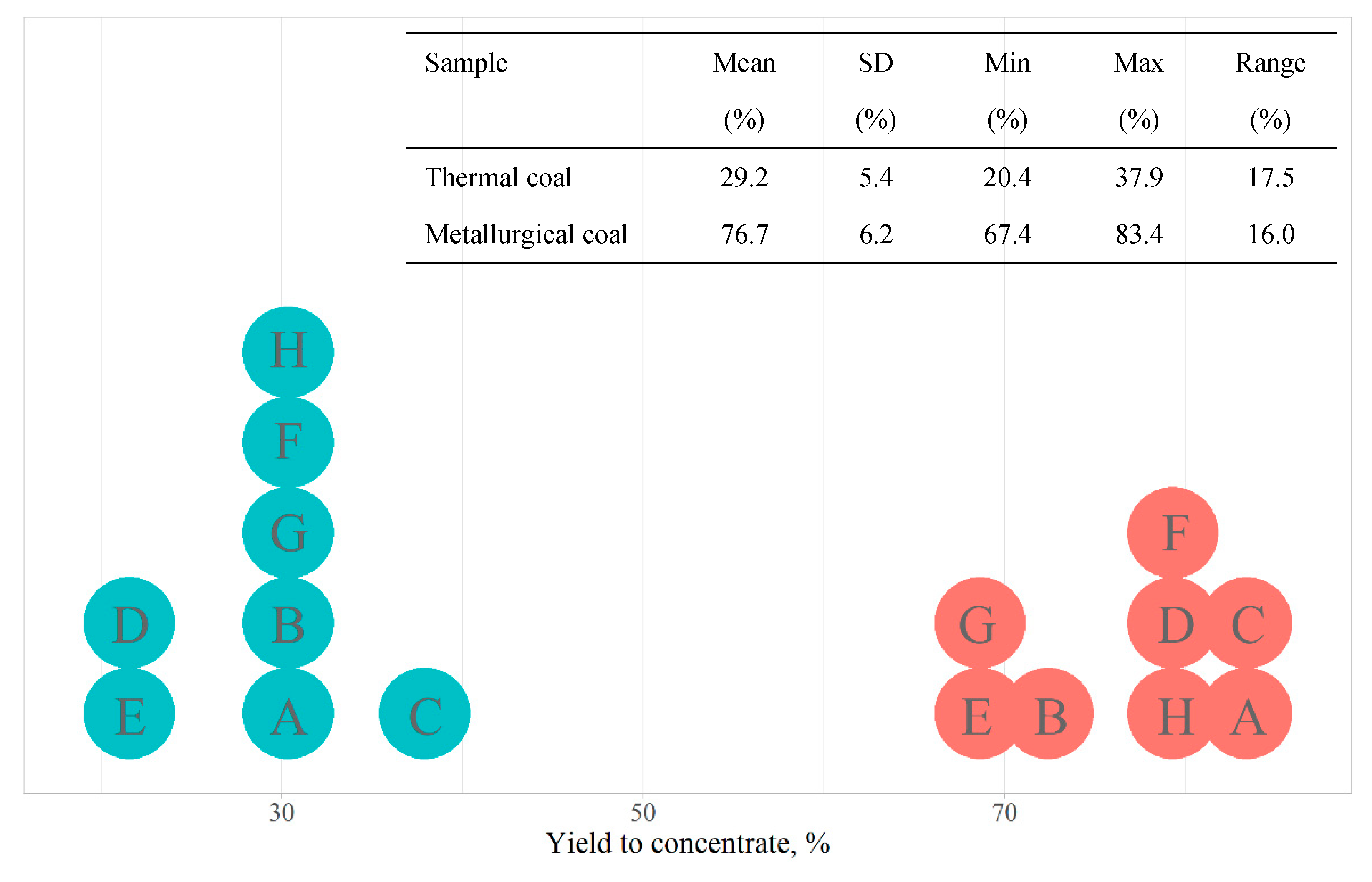


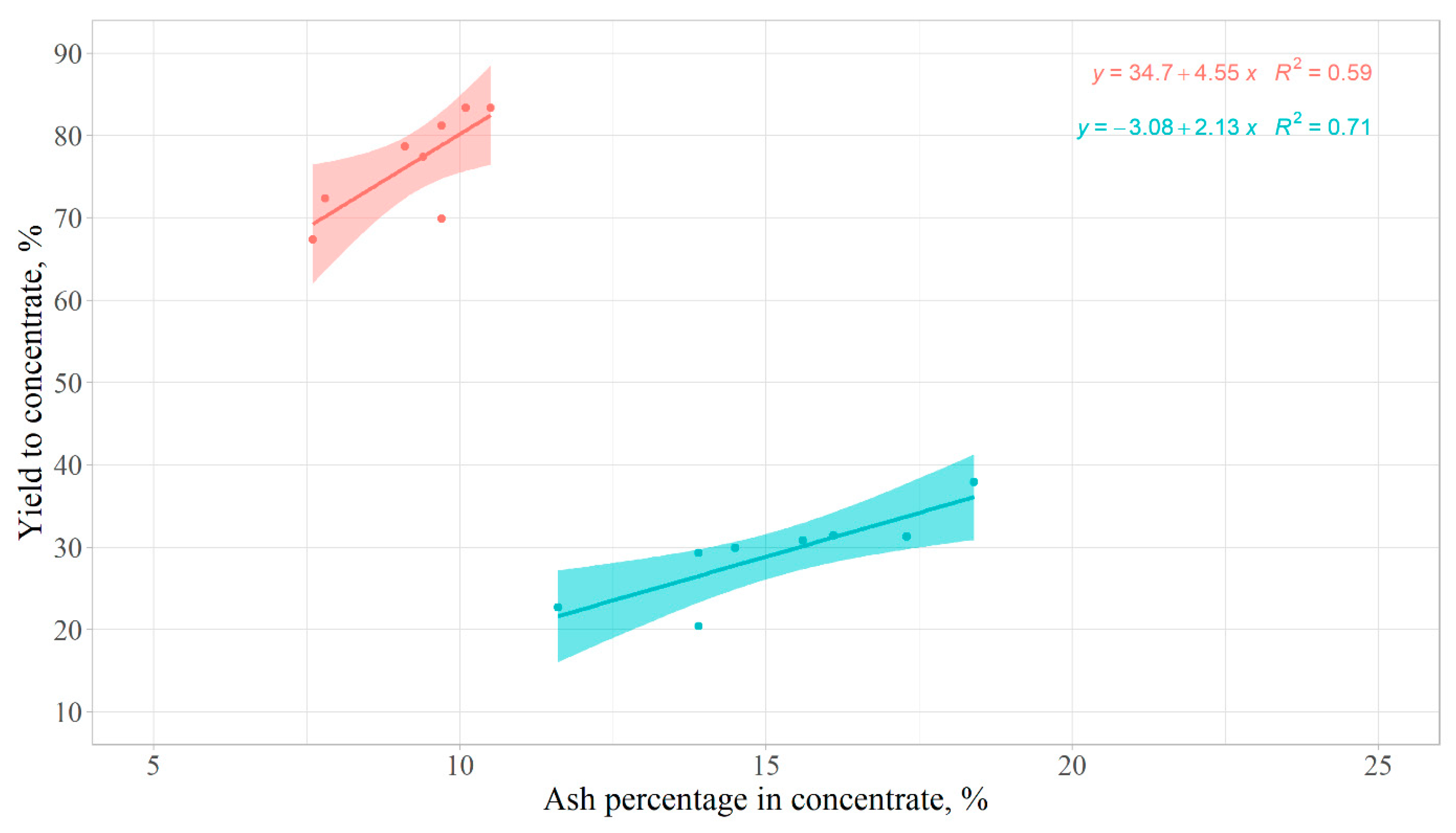
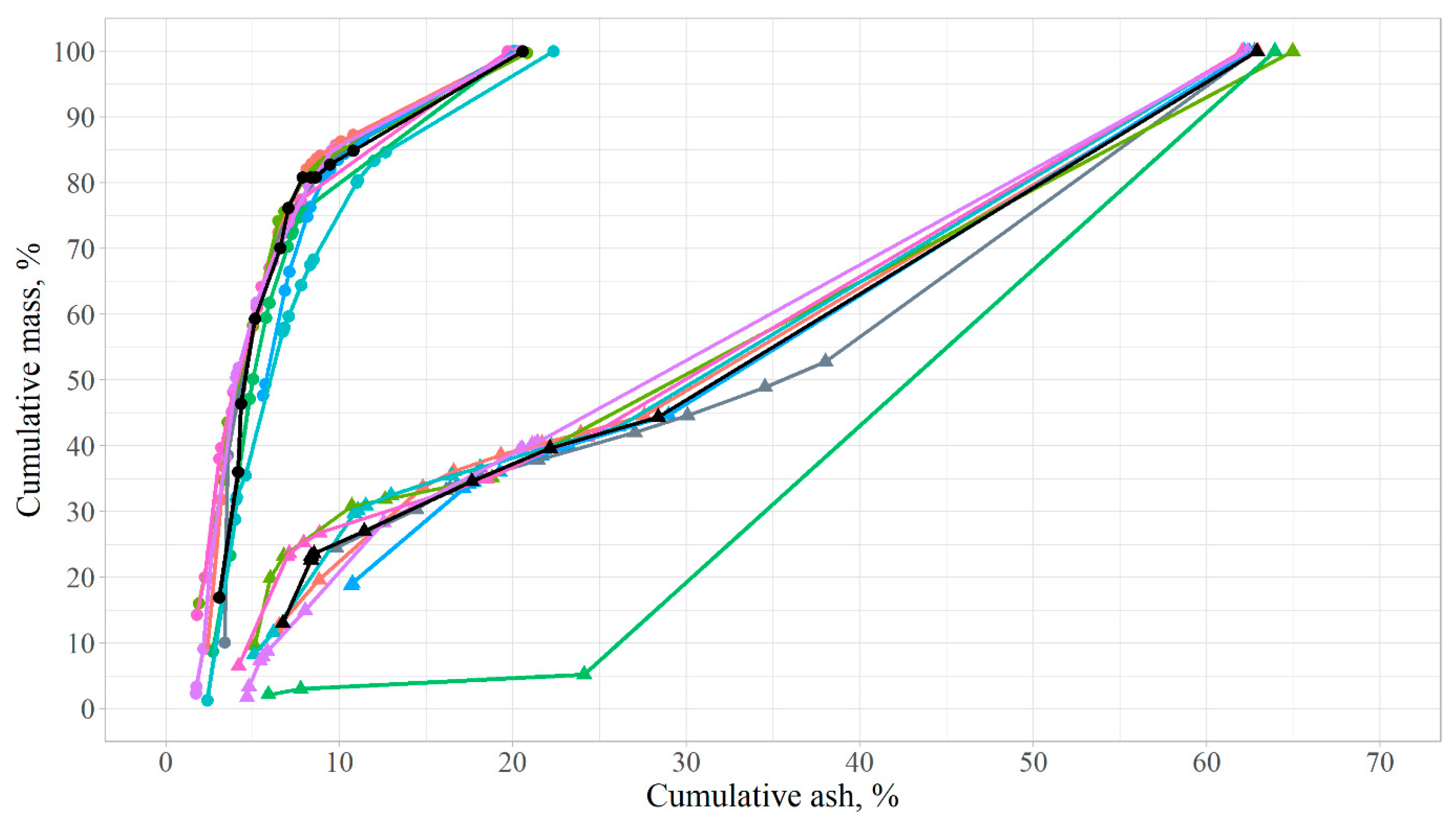
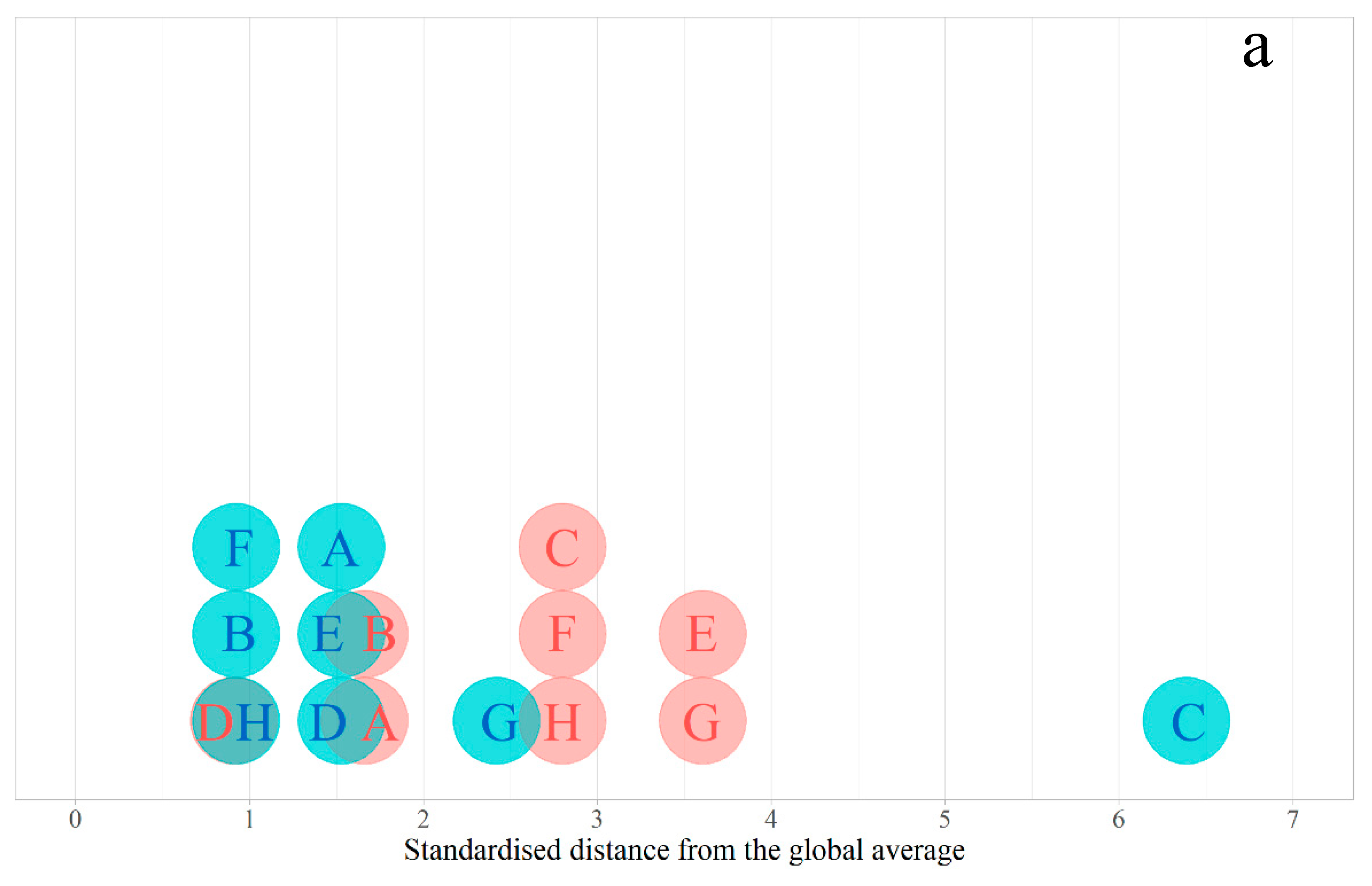
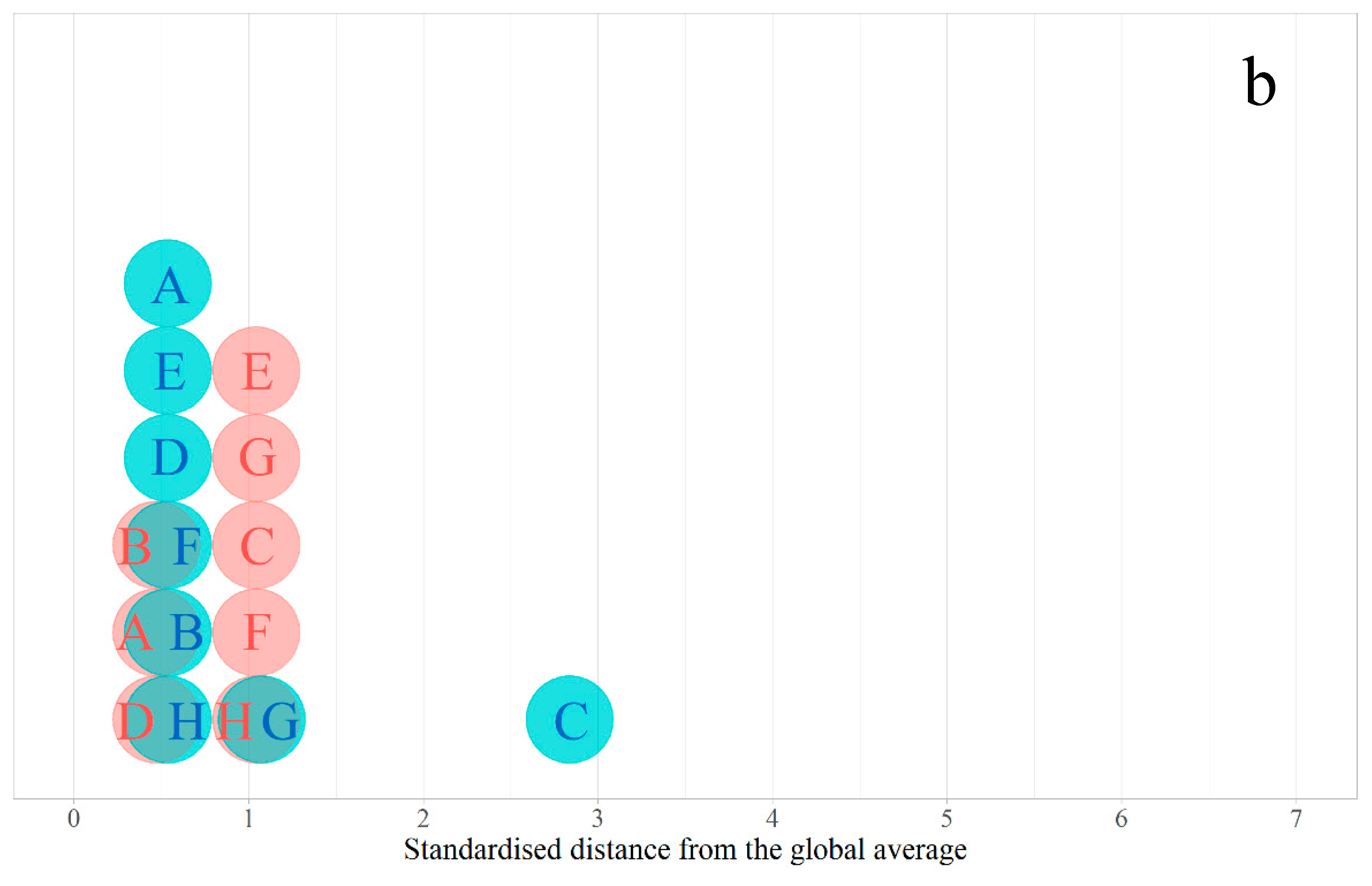
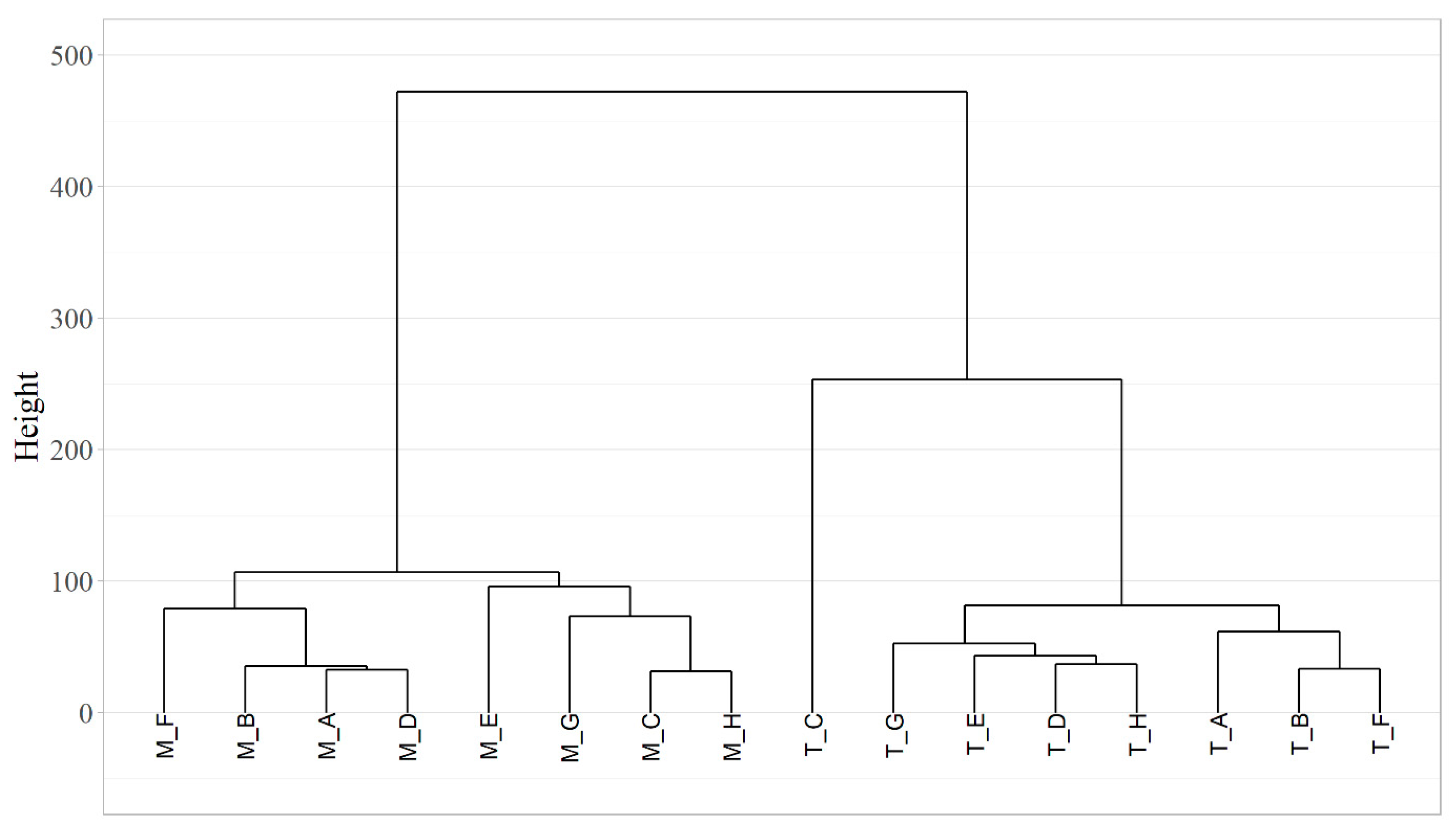
| Sample | Moisture, % | Ash, % |
|---|---|---|
| Thermal | 1.4 (1.2) | 62.8 (1.4) |
| Metallurgical | 1.0 (0.7) | 20.7 (0.5) |
| Sieve Size, μm | Thermal Coal | Metallurgical Coal | ||
|---|---|---|---|---|
| Mass Percentage Retained, % | Ash, % | Mass Percentage Retained, % | Ash, % | |
| 250 | 7.3 (2.3) | 47.1 (3.9) | 10.3 (3.3) | 18.4 (1.0) |
| 125 | 25.5 (3.1) | 57.8 (0.9) | 24.5 (3.8) | 18.0 (0.6) |
| 63 | 24.7 (4.4) | 62.4 (1.3) | 29.4 (8.9) | 20.0 (1.1) |
| pan | 42.6 (9.5) | 69.4 (4.9) | 35.7 (15.6) | 24.0 (1.4) |
| Criterion | Laboratory | |||||||
|---|---|---|---|---|---|---|---|---|
| A | B | C | D | E | F | G | H | |
| Date the test was conducted | ✓ | ✓ | ✓ | |||||
| Sample ID | ✓ | ✓ | ✓ | ✓ | ✓ | ✓ | ✓ | ✓ |
| Sample history | ||||||||
| Reference to the standard | ✓ | ✓ | ✓ | ✓ | ✓ | ✓ | ||
| Sample size analysis | ✓ | ✓ | ✓ 3 | |||||
| Sample ash analysis (by size fraction) | ✓ | ✓ | ✓ 1 | |||||
| Mass of coal (feed, concentrate, tailings) | ✓ 2 | ✓ 1 | ✓ | ✓ 2 | ✓ 1 | |||
| Ash percentage (feed, concentrate, tailings) | ✓ 1 | ✓1 | ✓ 1 | ✓ 2 | ✓ 1 | ✓ 2 | ✓ | ✓ 1 |
| Mass distribution (feed, concentrate, tailings) | ✓ 1 | ✓1 | ✓ 1 | ✓ 2 | ✓ 1 | ✓ | ✓ | ✓ 1 |
| Other properties | Moisture Collector | Moisture | Collector Flotation cell | |||||
| Format | .xls | .pdf, .xls | .pdf, .xls | .doc | ||||
| Criterion | Laboratory | |||||||
|---|---|---|---|---|---|---|---|---|
| A | B | C | D | E | F | G | H | |
| Date the test was conducted | ✓ | ✓ | ✓ | |||||
| Sample ID | ✓ | ✓ | ✓ | ✓ | ✓ | ✓ | ✓ | ✓ |
| Sample history | ||||||||
| Reference to the standard | ✓ | ✓ | ✓ | ✓ | ✓ | ✓ | ||
| Sample size analysis | ✓ 1 | ✓ | ✓ 1 | ✓ 1 | ||||
| Mass of coal (feed, concentrate, tailings) | ✓ 2 | ✓ | ✓ | ✓ | ✓ | |||
| Mass distribution (feed, concentrate, tailings) | ✓ | ✓ | ✓ 2 | ✓ | ✓ | ✓ | ✓ | |
| Ash percentage (feed, concentrate, tailings) | ✓ | ✓ | ✓ 2 | ✓ | ✓ | ✓ | ✓ | |
| Yield–ash relationship in a tabular form * | ✓ | ✓ | ✓ | ✓ 2 | ✓ | ✓ | ✓ | ✓ |
| Yield–ash relationship in a graphical form | ✓ | ✓ | ✓ 2 | ✓ | ✓ | |||
| Other properties | Moisture Collector | Moisture | Collector Flotation cell | |||||
| Format | .xls | .pdf, .xls | .pdf, .xls | .doc | ||||
| Lab | A | B | C | D | E | F | G | H | Mean |
|---|---|---|---|---|---|---|---|---|---|
| A | 0 | 76.0 | 405.0 | 117.9 | 84.2 | 47.5 | 192.3 | 85.0 | 144.0 |
| B | 76.0 | 0 | 279.4 | 62.0 | 37.7 | 33.3 | 61.1 | 49.5 | 85.5 |
| C | 405.0 | 279.4 | 0 | 133.2 | 264.3 | 297.6 | 198.1 | 194.2 | 253.1 |
| D | 117.9 | 62.0 | 133.2 | 0 | 42.9 | 69.4 | 62.4 | 36.9 | 75.0 |
| E | 84.2 | 37.3 | 264.3 | 42.9 | 0 | 56.0 | 45.2 | 43.1 | 81.9 |
| F | 47.5 | 33.3 | 297.6 | 69.4 | 56.0 | 0 | 111.7 | 54.4 | 95.7 |
| G | 192.3 | 61.1 | 198.1 | 62.4 | 45.2 | 111.7 | 0 | 50.6 | 103.1 |
| H | 85.0 | 49.5 | 194.2 | 36.9 | 43.1 | 54.4 | 50.6 | 0 | 73.4 |
| Mean | 144.0 | 85.5 | 253.1 | 75.0 | 81.9 | 95.7 | 103.1 | 73.4 | 114.0 |
| Lab | A | B | C | D | E | F | G | H | Mean |
|---|---|---|---|---|---|---|---|---|---|
| A | 0 | 34.0 | 79.2 | 32.7 | 103.8 | 67.3 | 76.7 | 73.6 | 66.8 |
| B | 34.0 | 0 | 106.6 | 36.9 | 108.3 | 96.1 | 79.3 | 105.8 | 81.0 |
| C | 79.2 | 106.6 | 0 | 80.8 | 88.7 | 134.0 | 73.0 | 31.7 | 84.9 |
| D | 32.7 | 36.9 | 80.8 | 0 | 80.0 | 74.3 | 96.1 | 74.4 | 67.9 |
| E | 103.8 | 108.3 | 88.7 | 80.0 | 0 | 160.0 | 100.2 | 99.4 | 105.8 |
| F | 67.3 | 96.1 | 134.0 | 74.3 | 160.0 | 0 | 223.5 | 124.7 | 125.7 |
| G | 76.7 | 79.3 | 73.0 | 96.1 | 100.2 | 223.5 | 0 | 73.3 | 103.1 |
| H | 73.6 | 105.8 | 31.7 | 74.4 | 99.4 | 124.7 | 73.3 | 0 | 83.3 |
| Mean | 66.8 | 81.0 | 84.9 | 67.9 | 105.8 | 125.7 | 103.1 | 83.3 | 89.8 |
| Coal | A | B | C | D | E | F | G | H | Mean Error | Error SD |
|---|---|---|---|---|---|---|---|---|---|---|
| Thermal | 54.7 | 30.1 | 200.6 | 41.4 | 42.5 | 36.7 | 76.0 | 21.2 | 62.9 | 58.1 |
| Metallurgical | 33.8 | 44.9 | 71.3 | 21.6 | 86.2 | 66.0 | 84.6 | 61.4 | 58.7 | 23.4 |
Publisher’s Note: MDPI stays neutral with regard to jurisdictional claims in published maps and institutional affiliations. |
© 2021 by the authors. Licensee MDPI, Basel, Switzerland. This article is an open access article distributed under the terms and conditions of the Creative Commons Attribution (CC BY) license (https://creativecommons.org/licenses/by/4.0/).
Share and Cite
Bournival, G.; Ata, S. An Evaluation of the Australian Coal Flotation Standards. Minerals 2021, 11, 550. https://doi.org/10.3390/min11060550
Bournival G, Ata S. An Evaluation of the Australian Coal Flotation Standards. Minerals. 2021; 11(6):550. https://doi.org/10.3390/min11060550
Chicago/Turabian StyleBournival, Ghislain, and Seher Ata. 2021. "An Evaluation of the Australian Coal Flotation Standards" Minerals 11, no. 6: 550. https://doi.org/10.3390/min11060550
APA StyleBournival, G., & Ata, S. (2021). An Evaluation of the Australian Coal Flotation Standards. Minerals, 11(6), 550. https://doi.org/10.3390/min11060550






